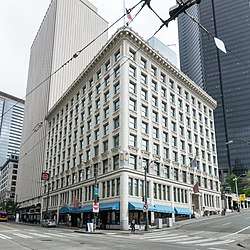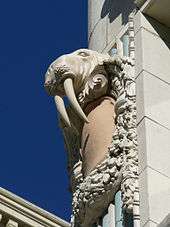Arctic Building
The Arctic Club Building is a nine-story hotel in Seattle, Washington located at the Northeast corner of Third Avenue and Cherry Street. Built in 1916 for the Arctic Club, a social group established by wealthy individuals who experienced Alaska's gold rush (Klondike Gold Rush),[3] it was occupied by them from construction until the club's dissolution in 1971. It is entirely faced with cream white terra cotta with submarine blue and orange-brown accents. It has terra cotta walrus-heads lining the third floor of the building and was also adorned with a polar bear. It is one of the finest examples of multi-colored matte glaze terra cotta work in the city.[4] Recently restored, the building has been adapted for use as a luxury hotel, Arctic Club Seattle (a DoubleTree by Hilton).[5] A roof garden used by the social club was replaced with a penthouse office suite.[4]
Arctic Building | |
 | |
 | |
| Location | Seattle, Washington |
|---|---|
| Coordinates | 47°36′13.380634″N 122°19′55.001405″W |
| Area | less than one acre |
| Built | 1916 |
| Architect | A. Warren Gould |
| Architectural style | Beaux-Arts |
| NRHP reference No. | 78002749[1] |
| Significant dates | |
| Added to NRHP | November 28, 1978 |
| Designated SEATL | December 13, 1993[2] |
It was designed by architect A. Warren Gould.[4] In 1978 it was listed on the National Register of Historic Places.[1]
History

The site of the Arctic building was originally owned by Joseph R. Lewis, the Chief Justice of Washington Territory and a direct descendant of George Washington's sister Betty. The home he built on the site in 1875 was considered one of the finest in Seattle at the time. The house was replaced in 1892 by the three-story, brick Seattle Theatre, designed by the firm of Saunders and Lawton. The newly formed Rainier Club occupied the office portion of the building until it and the theater were replaced by the Arctic Club Building in 1916.
The Arctic Club was formed in 1908 by successful veterans of the Klondike Gold Rush. The existing Alaska Club was merged that year into the Arctic Club. In Seattle, it was a fraternal men's club for businessmen with Gold Rush or Alaska connections.[6] Another Arctic Club was established in New York City, with membership based on exploration of wilderness areas in the Arctic. The Arctic Club in Seattle was initially located in 1909 on 3rd Avenue and Jefferson Street in the Morrison Hotel, also known as the Arctic Club Building.[7]
In 1914, after a dispute with the owner of that building, the Arctic Construction Company, the club board decided to relocate. In 1916, the members commissioned noted Seattle architect A. Warren Gould to design the Arctic Building in downtown Seattle at Third and Cherry as the group's headquarters. James Moses was the builder. During the move, members surreptitiously removed the bar from the original location by hoisting it out one of the windows. The 128 ft. Arctic Club building is in the Beaux-Arts style; it is known for its terra cotta walrus heads, indicative of the club's name, which adorn the third floor facade.
U.S. Congressman Marion Zioncheck committed suicide on August 7, 1936, by jumping from the window of his campaign office on the Arctic Building's fifth floor. His body struck the pavement directly in front of a car occupied by his wife.[8][9][10][11]
The building was owned for a time by the City of Seattle and was sold to a Spokane company, which redeveloped the property as a hotel, opening in 2008.[12] It operates as The Arctic Club of Seattle, a DoubleTree by Hilton hotel.[13]
References
- "National Register Information System". National Register of Historic Places. National Park Service. July 9, 2010.
- "Landmarks and Designation". City of Seattle. Retrieved March 4, 2013.
- "The hidden history of the Arctic Building".
- Lawrence Kreisman; Florence K. Lentz (June 1978). "National Register of Historic Places Inventory/Nomination: Arctic Building". National Park Service. Retrieved June 11, 2018. With accompanying three photos from 1978 (text also available here)
- Johnson, Richard L. "The Historic Arctic Building in Seattle Being Transformed into a 120-room Hotel; Arctic Club Hotel Seattle Will Be Managed by The Hotel Group / April 2007". www.hotel-online.com. Retrieved June 23, 2018.
- "About History Luxury Downtown Seattle Hotel Washington". Arctic Club Hotel. Archived from the original on February 18, 2009. Retrieved May 9, 2009.
- HistoryLink.org. Arctic Building (Seattle)
- "Zioncheck Kills Self In Five Story Plunge," Seattle Post Intelligencer, August 8, 1936, page 1
- Crowley, Walt (August 23, 2003). "Congressman Marion Zioncheck commits suicide on August 7, 1936". HistoryLink.org. Retrieved August 6, 2015.
- Royer, Bob (August 1, 2011). "Marion Anthony Zioncheck". The Cascadia Courier. Retrieved August 6, 2015.
- Grygiel, Chris (August 30, 2011). "Suicide - or murder? 75th anniversary of pol's sensational death". Seattle Post-Intelligencer.
- Chou, Kimberly (July 7, 2008). "Historic Arctic Club restored for new life as hotel". Seattle P-I. Retrieved December 15, 2012.
- "The Arctic Club Seattle - a DoubleTree Hotel". hilton.com. Retrieved August 6, 2015.
Further reading
- Ochsner, Jeffrey Karl. Shaping Seattle Architecture: A Historical Guide to the Architects. Rev. ed. Seattle: University of Washington Press, 1994. ISBN 0-295-97366-8
External links
| Wikimedia Commons has media related to Arctic Building, Seattle. |
- Club on Google Street View
- 1913 Image of Seattle Theatre, University of Washington Special Collections division.